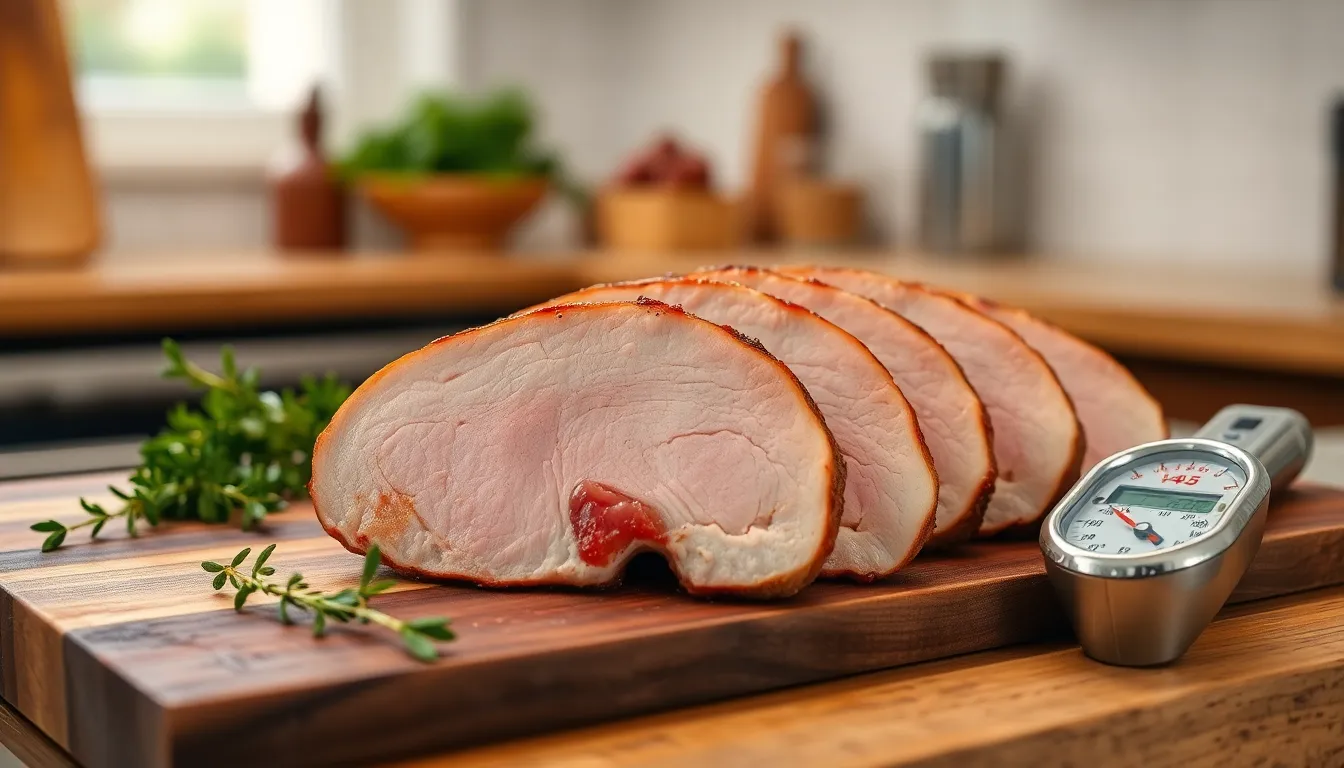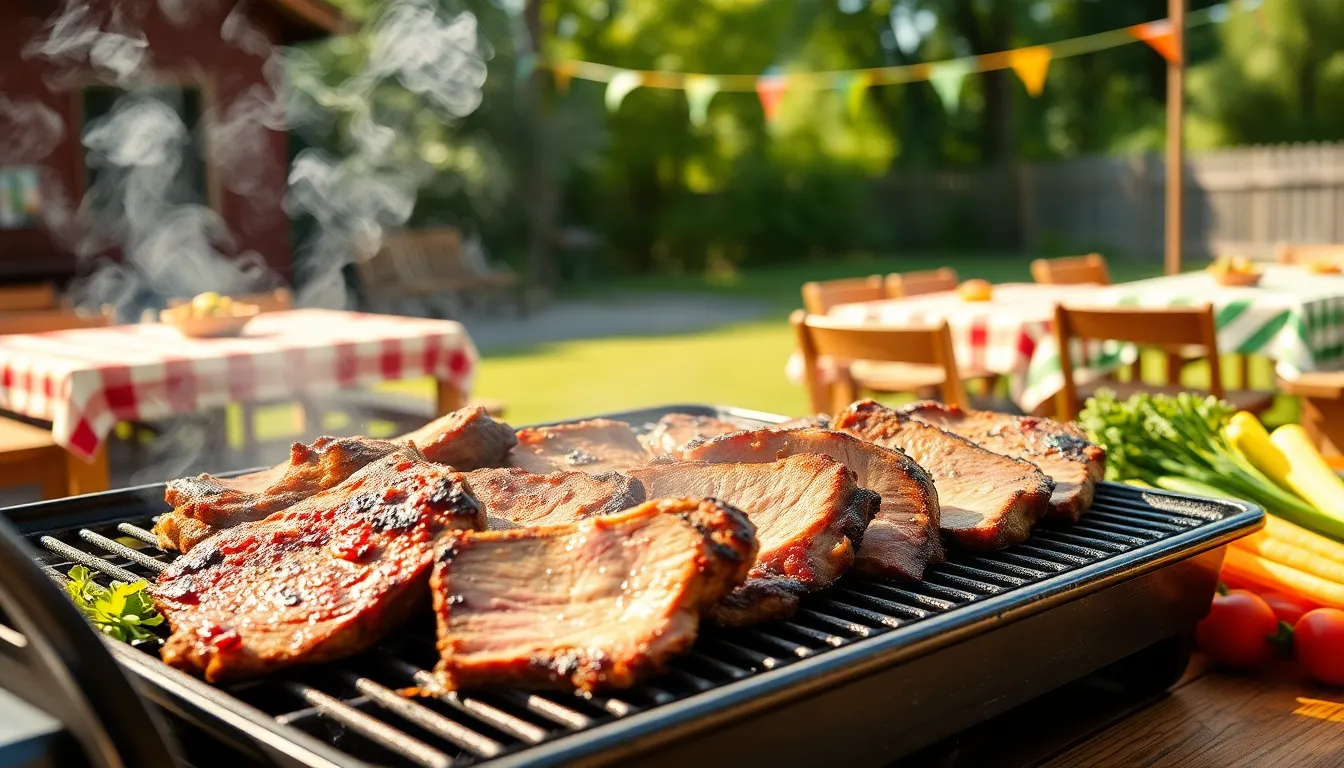Picture this: you’re hosting a backyard barbecue, the grill’s sizzling, and the aroma of marinated pork fills the air. But just as you’re about to serve the juicy chops, you notice a hint of pink inside. Panic sets in. Is it safe? Can pork really be pink and still be delicious?
Table of Contents
ToggleCan Pork Be Pink Inside?
Pink pork can raise concerns about safety when served. The USDA sets the safe minimum internal temperature for pork at 145°F (63°C) followed by a three-minute rest time. This temperature allows for a slightly pink color while ensuring harmful bacteria are destroyed during cooking.
Pork can appear pink even when cooked to the proper temperature due to several factors. Myoglobin, a protein in muscle tissue, can cause a pink hue, especially in younger pigs. Factors like breed, diet, and cooking method also affect coloration.
People often confuse doneness with safety. Observing the color isn’t the best indicator of whether pork is properly cooked. Using a meat thermometer provides accuracy and reassurance.
Different cuts of pork may also exhibit varied color retention. For example, pork loin or tenderloin might show pinkness, while ground pork should always be cooked thoroughly. Following these guidelines ensures enjoyment without compromising safety.
Enjoying perfectly cooked pork, even with a slight pink, is possible with proper handling. It’s essential to prioritize correct cooking temperatures and methods to savor a delicious meal without fear.
Understanding Pork Cooking Temperatures

Pork requires attention to cooking temperatures for safety and quality. Proper cooking not only eliminates harmful bacteria but also affects the texture and flavor.
Safe Internal Temperatures for Pork
USDA guidelines state that pork must reach an internal temperature of 145°F (63°C). This temperature ensures safety when followed by a three-minute rest period. Cuts such as pork loin and tenderloin can retain some pinkness at this temperature due to myoglobin. A meat thermometer offers the most reliable method to verify the internal temperature, confirming that pork is cooked safely. For ground pork, a minimum of 160°F (71°C) is necessary, as it should not show any pink color. Adherence to these guidelines ensures that pork remains healthy to eat while allowing for slight coloration.
Myths About Pink Pork
Many misconceptions surround the pink color in pork. Some believe that any pink means undercooked meat. Others insist that pork must always be white for safety. In reality, factors like the pig’s breed, diet, and cooking method influence color. Cooked pork may still exhibit a pink tint yet be perfectly safe. It’s essential to differentiate color from doneness, as the only true measure of safety is reaching the recommended internal temperatures. Awareness of these myths helps in understanding that enjoyment of pork remains possible, even when the interior appears pink.
Factors Affecting Pork Color
Understanding the elements that influence pork color aids in making informed decisions about its doneness and safety.
Type of Pork Cuts
Different pork cuts display varying color characteristics. Tender cuts like pork loin and tenderloin may retain a pink hue even when cooked to safe temperatures. These cuts are more prone to staying pink due to their muscle structure and lower fat content. In contrast, larger cuts such as pork shoulder often cook to a uniform whitish color. Ground pork must be cooked entirely without any pinkness, as its texture and fat distribution leave it vulnerable to bacterial contamination if not cooked properly. Recognizing these differences assists in determining appropriate cooking times and methods.
Cooking Methods
The cooking technique impacts the final color of pork. Grilling and smoking often leave pork with a pink center due to the Maillard reaction and smoke ring formation, which may create a blush color despite achieving safety temperatures. Roasting and sautéing generally cook pork evenly, leading to less retained pink. Cooking pork at lower temperatures for extended periods, such as sous vide, can also preserve pinkness while ensuring tenderness. Thus, proper cooking methods combined with accurate temperature measurement guarantee both a safe and flavorful outcome.
Health Risks of Undercooked Pork
Consuming undercooked pork poses serious health risks. Pork can harbor pathogens such as Salmonella, E. coli, and Trichinella spiralis, which can lead to foodborne illnesses. Trichinella, a parasitic roundworm, causes trichinosis, resulting in muscle pain, fever, and gastrointestinal symptoms. Symptoms often appear within a week of consumption, presenting challenges for diagnosis and treatment.
Salmonella and E. coli are also common health concerns. They cause abdominal cramps, diarrhea, and fever, with severe cases requiring medical attention. According to the Centers for Disease Control and Prevention (CDC), approximately 1 million cases of salmonellosis occur each year in the U.S. The risk of infection increases when pork is not cooked to the recommended internal temperature of 145°F (63°C), which kills these harmful pathogens.
Certain groups, including pregnant women, young children, the elderly, and individuals with weakened immune systems, face heightened risks from undercooked pork. For these populations, even a slight exposure can lead to serious health complications. It’s crucial to ensure that all cuts of pork are cooked thoroughly to minimize risks.
Using a meat thermometer is the most reliable way to verify doneness. Relying solely on color can mislead consumers. Even correctly cooked pork loin or tenderloin may exhibit pink hues due to factors such as myoglobin content.
Preventing foodborne illness hinges on proper pork handling and cooking. Avoiding cross-contamination in food preparation areas further lowers risks. Adhering to safe cooking practices allows individuals to enjoy pork dishes while ensuring health and safety.
Pork can indeed be pink inside without compromising safety when cooked correctly. Understanding the factors that influence color helps clarify that pink isn’t always a sign of undercooked meat. Using a meat thermometer is essential to ensure pork reaches the recommended internal temperature, allowing for a juicy and flavorful meal. By embracing proper cooking techniques and being informed about doneness, individuals can confidently enjoy pork that’s both safe and delicious.








